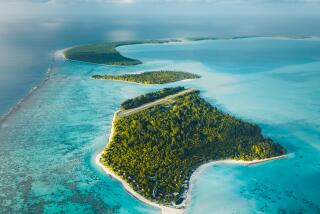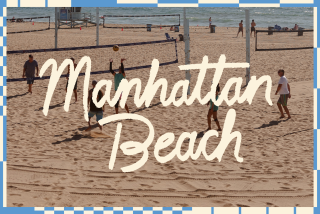Becoming an insider in Eleuthera
Eleuthera, Bahamas — A sprawling black stingray glided toward me as I lazed on my inflatable raft, moving as gracefully as a magic carpet through the clear, waist-deep water. It resembled Caribbean scenes I’d seen a hundred times on TV commercials.
But this wasn’t a cruise or even a resort. These were the open, uncrowded waters of Eleuthera, a rugged Bahamian island where swimmers are more likely to see bonefish and barracuda than other tourists.
Just a mile or so wide and 110 miles long, Eleuthera is a lanky squiggle of land between the Caribbean Sea and the Atlantic Ocean. It’s part of the 700-plus-island chain that constitutes the Bahamas, a British commonwealth better known for the touristy resorts and casinos of Nassau and mega-entertainment hotels like the Atlantis on Paradise Island.
Eleuthera is different. Just an hour’s flight east of Miami, the island feels as if it is 10 time zones removed. Most tourists who venture here stick to north Eleuthera, where a short cab and ferry ride from the local airport takes them to Dunmore Town on tiny Harbour Island. Here, plush hotels and resorts, upscale shops, restaurants and nightclubs cater to jet-setters from around the world.
But my husband, John, and I had come for a different island experience, one of isolated beaches rather than yachts, and more of bird songs than big money. We had come for the quiet that a fellow writer had recommended, away from city sounds and traffic. We were looking for the chance to meet the people who lived here, for the opportunity to do nothing for hours -- maybe days -- at a time.
We’d heard that Eleuthera has an enigmatic charm and a rhythm all its own. And we learned that, for getting to know this elusive isle, there’s nothing better than a beach house to call your own for a week or two.
Rent a house on the island -- they’re commonly called villas, no matter what their square footage -- and you’ll be privy to a far different lifestyle than you would find at the big Bahamas resorts. On Eleuthera, accommodations range from elegant beachfront estates to colorful cottages a short walk from the water. Come at the end of high season, say in May, June or July, and prices can be less than $100 a day for two.
Villas, easily found on the Internet, generally can be rented by the night or week. Towels, linens and cookware are usually included; for an extra charge, you can arrange housekeeping services, a rental car or a guide.
We chose to search the area near Governor’s Harbour, the island’s capital. The laid-back town is home to a small airport on the outskirts, a handful of grocery and liquor stores, a few gas stations, the regional medical center and several local attractions, such as a small orchid farm, a library and some lovely pastel-painted old homes. It’s a good place to stock up on ice, water, groceries and information before driving south along the two-lane Queen’s Highway to even smaller communities such as Savannah Sound, Tarpum Bay and Palmetto Point.
Finding a villa
As in any part of the world, choosing a villa from the dozens advertised on the Internet is two parts research, one part intuition, plus a big splash of luck. For our first trip to Eleuthera, John and I checked travel books and visitor-oriented Web sites. We eliminated the north end as too commercial, the south end as too remote to make a good base for exploring. Armed with Web tips for two restaurants in Palmetto Point, we narrowed our field, using Google as our search engine and typing in key words such as “villa,” “rental” and “Palmetto Point.” We found several appealing-looking cottages.
We also checked out some villas on nearby Windermere Island, a favorite of the British royal family and other well-heeled folk. It was here that a pregnant Princess Diana was photographed in a bikini by some enterprising paparazzi, to the reputed displeasure of the queen. Alas, the stunning beachfront houses on this private enclave command fees of $5,000 to $10,000 a week.
After narrowing our choices to three villas in our price range and calling the owners for specifics, we made our decision. For two years in a row, we have rented a compact two-bedroom villa perched on a cliff above quiet Ten Bay, about four miles south of Palmetto Point. Like many of the rental homes in the area, the house takes advantage of the sea with a wraparound deck furnished with hammock, chaise longues and chairs -- perfect for taking in the sunset with a cold Kalik, the local beer.
Inside, the master bedroom, living room and small but well-stocked kitchen also overlook the water. A tiny second bedroom and full bath offer views of tropical vegetation. Throughout there is the steady chirping of cicadas and the constant rustle of coconut palms punctuated by the splash of waves against the reef.
Beneath the house, in the cistern, there’s an occasional raucous outburst of frogs competing for a foothold in the tank. No need to be alarmed: “Frogs in da cistern, da water is good,” goes an old Eleutheran saying. That said, it’s still a good idea to buy bottled water for drinking and cooking.
There’s no broadcast TV in the house, just a stereo, a VCR and a selection of taped movies. We’ve never felt the urge to use any of them, preferring the sounds of wind and water. For entertainment, we bring our own masks and snorkels, along with a cheap inflatable raft, polarized sunglasses and sun block. In the past, we’ve rented one of the island’s aging cars to explore some of the communities around Ten Bay.
Driving here requires a little extra concentration; in the Bahamas you drive on the left. Because most cars are standard American models, with the steering wheel on the left, this can be unnerving. But our beat-up Mercury came with a handy sticker across the windshield reading: “Keep left!”
A classic tropical beach
Our drives helped us find other possible rental areas: on the Atlantic side of North Palmetto Point (north and south of the Unique Village Resort), at Double Bay (a broad pink sand beach on the Atlantic) or in Governor’s Harbour near the old Club Med. Along the Caribbean, we also saw several cute beachfront cottages sprinkled along Queen’s Highway from Governor’s Harbour south to Tarpum Bay.
But the porch overlooking Ten Bay continues to draw us. Situated on the calm Caribbean side of the island (the Atlantic side tends to be windier, with bigger waves), Ten Bay rates a 10-plus. It sits at the end of a winding, poorly marked, heavily rutted dirt road off Queen’s Highway, like a hideaway straight out of central casting.
The beach is a classic island postcard, without the crowds: a spectacular crescent of sand fringed by wind-sculpted pines and palms. Ten Bay’s shell-strewn beach slopes gently into water that seems to be a thousand gradients of blue. Shallow and warm -- 82 degrees during our visits in early May -- Ten Bay enables waders and snorkelers to venture out several hundred yards without getting in over their heads.
The villa’s owners have stocked the house with books and magazines, a selection of board games and bug repellent. Mosquitoes and no-see-’ums can be brutal nearly any time of year, especially on windless days and nights. To keep them at bay, at least inside, we bring our own plug-in mosquito destroyers and a mosquito net to hang over the bed.
Along with instructions about what to do in case of a hurricane (the official season is June to November) and comments from previous renters, the villa’s guest book includes a list of recommended places to eat. The list is invaluable. Although we cook sometimes, the native Bahamian cuisine is irresistible.
Fresh from the sea
Cracked conch (fresh queen conch, pounded for tenderness and quickly deep-fried) is an island specialty. It’s served alone, with French fries, with coleslaw, in sandwiches, even on top of pizza. The flavor is reminiscent of abalone; the texture, calamari-esque. Order cracked conch, and the rhythmic pounding of the meat teases you from the kitchen as you wait for the crispy, hot results to arrive.
Baked chicken (every yard seems to host a few hens and a rooster), steamed local grouper, pork chops and barbecued pork ribs are other standbys. On the side is peas ‘n’ rice, a savory casserole of black-eyed peas, rice, tomatoes and a fragrant dash of thyme, often fortified with salt pork or bacon. For dessert, local cooks often serve guava or pineapple duff, which resembles a fresh-fruit-filled jelly roll.
We’re regulars at several restaurants, but our favorite is Mate & Jenny’s, Palmetto Point’s neighborly bar and pizza place. Cooled by ceiling fans and illuminated by Christmas lights and bright smiles all year round, Mate & Jenny’s feels like home. Proprietor Maitland Bethel, an Eleutheran native, serves up delicious pepperoni or conch pizzas and potent Goombay smash rum drinks along with witty conversation and a hug for return visitors.
Unique Village is another worthwhile restaurant, as well as an adventure to find. There’s no address for this dining room and resort on the Atlantic side of Palmetto Point, but most locals can give you directions. A bit more upscale than other local eateries, Unique Village offers reasonably priced meals, a full bar, one of the best burgers on the island and fresh fruit duffs for dessert. Then there’s the view: Tables inside and on the deck overlook one of Eleuthera’s storied beaches, its sand tinted a delicate pink by trillions of ground-up shells.
You’ll find another pink sand beach near the former Club Med near Governor’s Harbour. The once-bustling club facing the Atlantic has been closed since Hurricane Floyd blew through in 1999, but you can ask the guard on duty for directions to the nearby beach. A short walk down a jungly trail, and the flour-textured sand awaits, often with no other tourists in sight.
One thing we learned: Most of the beaches don’t offer the spectacular array of tropical fish you see in Hawaii or Tahiti. Serious snorkelers and scuba divers prefer other locations in the Bahamas, such as Abaco or Andros Island. Eleuthera is about sun and sand, hunting for shells and lolling in the shallows. And the sport of bonefishing.
For rod-and-reel connoisseurs, the beach at Ten Bay is one of the top spots in the world for the lean, hard-fighting fish, which is typically caught and released. We spent many an hour on our porch watching a couple of British anglers cast in vain for the skittish fish that lingered just beyond their hooks. Eleuthera’s waters also are home to barracudas, the occasional porpoise, lots of starfish, sand dollars, long-legged shorebirds and giant stingrays.
The first time I spotted a 6-foot ray heading toward my slippery little raft, I’ll admit I wished I could walk on water. Those silent, rippling wings looked ominous, and the beach seemed miles away.
But as I clung to my float, lifting my toes above the water and wondering what stingrays like to eat, the big fish coasted to a stop right beneath me. Four feet down, almost close enough to touch, it was the gentle essence of what makes Eleuthera so magical.
No crowds, no worries. That’s what island style is all about.
More to Read
Sign up for The Wild
We’ll help you find the best places to hike, bike and run, as well as the perfect silent spots for meditation and yoga.
You may occasionally receive promotional content from the Los Angeles Times.






